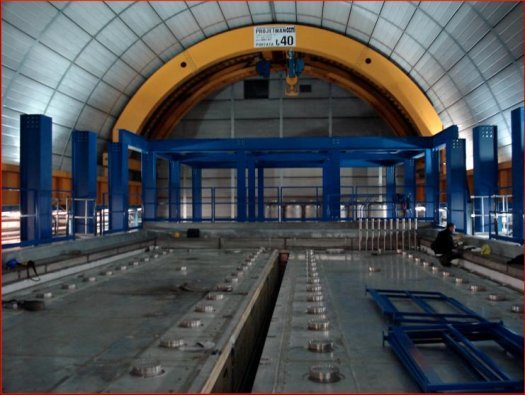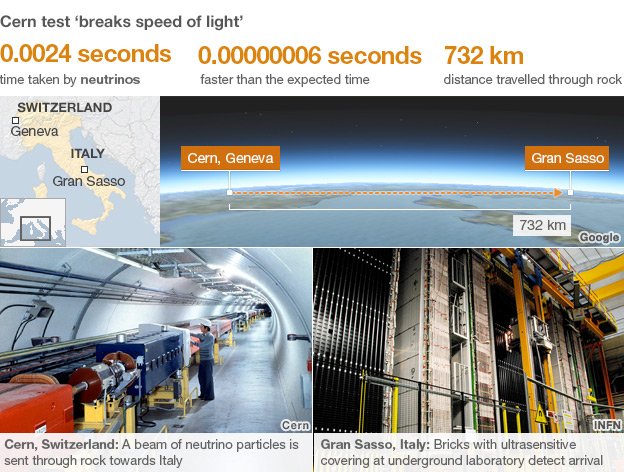A new experiment repeating the test of the speed of neutrinos has found that the subatomic particles do not travel faster than light.
Results announced in September suggested that neutrinos can exceed light speed, but were met with skepticism as that would upend Einstein’s theory of relativity.
A test run by a different group, ICARUS, at the same laboratory has now clocked them travelling at precisely light speed.
The results have been posted online.
The results in September, from the OPERA group at the Gran Sasso underground laboratory in Italy, shocked the world, threatening to upend a century of physics as well as relativity – which holds the speed of light to be the Universe’s absolute speed limit.
Now the ICARUS group, based at the same laboratory, has weighed in again, having already cast some doubt on the original OPERA claim.
Shortly after that claim, Nobel laureate Sheldon Glashow co-authored a Physical Review Letters paper that modeled how faster-than-light neutrinos would behave as they travelled.
In November, the ICARUS group showed in a paper posted on the online server Arxiv that the neutrinos displayed no such behavior.

The ICARUS group found that the neutrinos do travel at the same speed as light, within a small error range
However, they have now supplemented that indirect result with a test just like that carried out by the OPERA team.
The ICARUS experiment uses 600 tons – 430,000 litres – of liquid argon to detect the arrival of neutrinos sent through 730 km of rock from the CERN laboratory in Switzerland.
Since their November result, the ICARUS team has adjusted their experiment to do a speed measurement.
What was missing was information from CERN about the departure time of the neutrinos, which the team recently received to complete their analysis.
The result: they find that the neutrinos do travel at the same speed as light, within a small error range.
“We are completely compatible with the speed of light that we learn at school,” said Sandro Centro, co-spokesman for the ICARUS collaboration.
Dr. Sandro Centro said that he was not surprised by the result.
“In fact I was a little skeptical since the beginning,” he said.
“Now we are 100% sure that the speed of light is the speed of neutrinos.”
Most recently, the OPERA team conceded that their initial result may have been compromised by problems with their equipment.
Rumors have circulated since the OPERA result was first announced that the team was not unified in its decision to announce their findings so quickly, and Dr. Sandro Centro suggested that researchers outside the team were also suspicious.
“I didn’t trust the result right from the beginning – the way it was produced, the way it was managed,” Dr. Sandro Centro said.
“I think they were a little bit in a hurry to publish something that was astonishing, and at the end of the day it was a wrong measurement.”
Four different experiments at Italy’s Gran Sasso lab make use of the same beam of neutrinos from CERN.
Later this month, they will all be undertaking independent measurements to finally put an end to speculation about neutrino speeds.
The MINOS experiment in the US and the T2K experiment in Japan may also weigh in on the matter in due course – if any doubt is left about the neutrinos’ ability to beat the universal speed limit.
Faster-than-light neutrinos experiment that might have been the biggest physics story of the past century may instead be down to a faulty connection.
In September 2011, the OPERA experiment reported it had seen particles called neutrinos evidently travelling faster than the speed of light.
The team has now found two problems that may have affected their test in opposing ways: one in its timing gear and one in an optical fibre connection.
More tests from May will determine just how they affect measured speeds.
The OPERA collaboration (an acronym for Oscillation Project with Emulsion-Racking Apparatus) was initially started to study the tiny particles as they travelled through 730km of rock between a particle accelerator at the European Organization for Nuclear Research (CERN) in Switzerland and the Gran Sasso underground laboratory in Italy.
Its goal was to quantify how often the neutrinos change from one type to another on the journey.
But during the course of the experiments the team found that the neutrinos showed up 60 billionths of a second faster than light would have done over the same distance – a result that runs counter to a century’s worth of theoretical and experimental physics.
The team submitted the surprising result to the scientific community in an effort to confirm or refute it, and several other experiments around the world are currently working to replicate the result.

Faster-than-light neutrinos experiment that might have been the biggest physics story of the past century may instead be down to a faulty connection
A repeat of the experiment by the OPERA team will now address whether the issues they have found affect the ultimate neutrino speed they measure.
The two problems the team has identified would have opposing effects on the apparent speed.
On the one hand, the team said there is a problem in the “oscillator” that provides a ticking clock to the experiment in the intervals between the synchronizations of GPS equipment.
This is used to provide start and stop times for the measurement as well as precise distance information.
That problem would increase the measured time of the neutrinos’ flight, in turn reducing the surprising faster-than-light effect.
But the team also said they found a problem in the optical fibre connection between the GPS signal and the experiment’s main clock.
In contrast, the team said that effect would increase the neutrinos’ apparent speed.
Only repeats of the experiments by OPERA and other teams will put the matter to rest.
“These latest developments show how hard the OPERA team is working to understand the results,” said Dave Wark, a particle physicist from the Rutherford Appleton Laboratory in the UK and committee member of Japan’s principal neutrino facility T2K.
“Just as it would have been unwise to jump to the conclusion that the initial results were the result of an anomaly, it would be unwise to make any assumptions now. It is the nature of science that theories have to be tested, re-tested and then tested again”.
In a statement, the OPERA collaboration said: “While continuing our investigations, in order to unambiguously quantify the effect on the observed result, the collaboration is looking forward to performing a new measurement of the neutrino velocity as soon as a new bunched beam will be available in 2012.”
Meanwhile, the Borexino and Icarus experiments, also at Gran Sasso, the Minos experiment based at the US Fermilab, and Japan’s T2K facility are all working on their own neutrino speed measurements, with results expected in the next few months.


